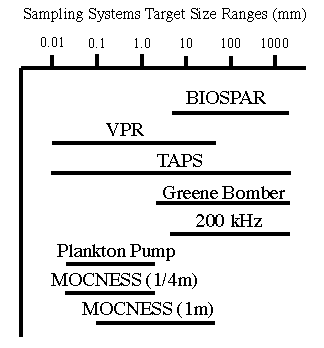
Plankton Pump (Green and Incze): A plankton pump equipped with 20 Ám mesh collects discrete depth samples of organisms down to the smallest copepod life stages. Analysis of these samples will provide taxonomic and life history stage composition of the larval prey field.

BIOSPAR (Wiebe): BIOSPAR (BIOacoustic Sensing Platform And Relay), is an autonomous dual-beam biological echo sounder system and satellite and radio communications systems mounted in a spar buoy. BIOSPAR carries two down-looking transducers, one operating at 420 kHz and the other operating at 120 kHz. Profiles of acoustic backscattering are obtained in 1 m depth intervals in the upper 100 m.
Greene Bomber (Wiebe and Greene): A towed, dual-beam acoustic system operating at 420 kHz and 1 MHz provides continuous profiles of the water column for zooplankton with a size range of 1.5 mm to 100 mm.
Video Plankton Recorder (Davis): A Video Plankton Recorder (VPR), under development with NSF funds, measures the distribution of larval fish prey taxa on scales from microns to kilometers. The VPR allows real time, high-resolution (< 10 Ám), video observations of planktonic organisms (and other particulate matter). The field of view of the optics allows organisms from 100 Ám to > 1 cm to be identified to major taxa (i.e., nauplii, copepodite, chaetognaths, etc.).
TAPS (Green and Berman): The Tracor Acoustic Profiling System developed by V. Holliday of Tracor Inc. uses a four transducer array operating at frequencies 265 kHz, 420 kHz, 1.1 MHz, and 3 MHz. The transducer array is designed to provide information on the distribution of individual organisms ranging in size from individual copepods to nauplii at distances of 2-3 m.
Towed 120 & 200 KHz System (Green and Berman): A towed body with 120 kHz and 200 kHz dual-beam transducers provides synoptic horizontal mapping of macrozooplankton concentrations (Macaulay et al. 1990). The system can efficiently provide the broadscale context in which the localized observations from the other systems occur.